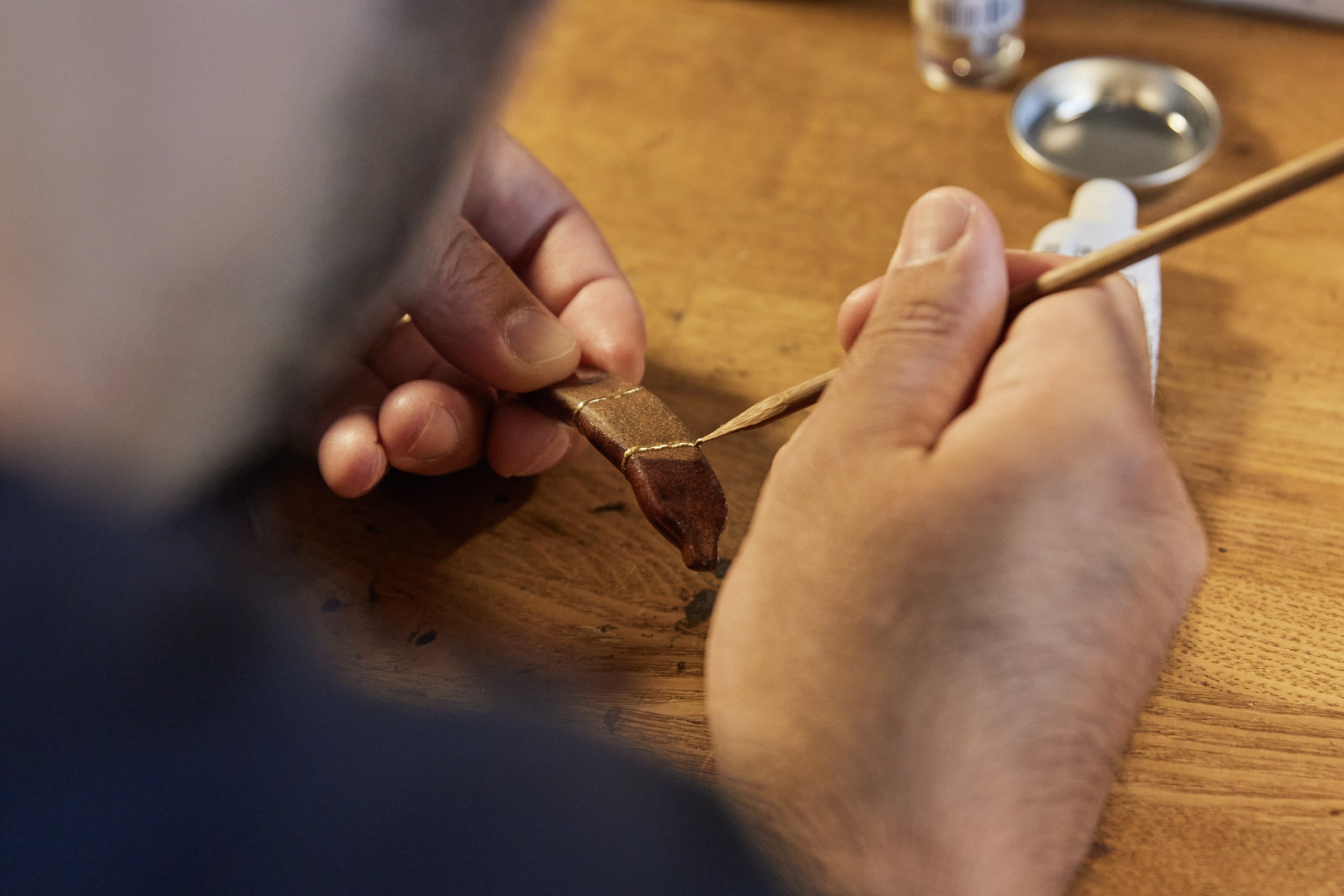Kirin Beer, Lacquerware, and the Mystery Behind the Bottle
By Benjamin Korman
On the handles of a beer tap behind the counter of a cheap izakaya; on icy, sweating cans in the refrigerated shelves of a konbini convenience store: these are some of the last places you would expect to encounter work by one of Japan’s most celebrated masters of traditional lacquerware. But it is commonly believed that the work of one such craftsman—the internationally renowned artist Shisui Rokkaku—is behind Kirin Brewery’s ubiquitous logo.
In the collective consciousness, there is a wide valley separating the practices of Japanese traditional craft from the country’s modern-day romance with beer. The art of Japanese lacquerware, or urushi, dates back almost nine millennia, and the complexly produced, elegantly ornamented, and highly valuable objects that the word evokes can be traced back as far as the Nara period in the eighth century. These objects are prized across the world for embodying the beauty of Japanese art. To those outside Japan, they may only live behind glass in a museum. But for centuries, aristocrats have treasured lacquerware objects in their everyday lives: plates, bowls, and other tableware; incense holders for ceremonies; glittering cabinets, screens, and trays; even combs, belt buckles, and other bodily ornaments. These objects are instantly recognizable for their reflective, mirrorlike textures in bold shades of deep black and red. Their beauty is enhanced even further with the addition of gold and silver flakes, in a technique known as maki-e.
So, why is lacquerware valued so highly? The answer lies in the requirements of materials and expertise. For one, it takes a great deal of effort to cultivate lacquer. The sticky material is made from a sap originating from the Toxicodendron vernicifluum, a toxic tree belonging to the same plant family as poison ivy and poison oak. The sap is cultivated by scoring the sides of the tree and allowing it to seep out into containers. Each tree produces only enough lacquer per year to fit inside a disposable water bottle.
Before even a single drop of lacquer is applied to carved wood, many urushi crafts are already (considered) masterpieces. Be it a lively relief sculpture of a natural scene, an expertly constructed geometric form, or anything else, the surface is often the final step in creating an object of indisputable beauty. But when the application process starts, it is both intensive and time-consuming. It is not unusual for a lacquerware object to include one hundred—or even one thousand—coats, with long phases of drying and polishing in between. The maki-e application of gold and silver powder requires equally tremendous skill.
This emphasis on mastery and attention to detail defines Japanese traditional and historical aesthetic culture. Even in the face of Japan's opening to foreign countries in the mid-1800s, and the nation's resulting and rapid modernization, Japan maintained this dedication to craftsmanship and mastery. The subsequent arrival and import of beer would prove no exception.
According to the Brewers Association of Japan, the first-ever beer in Japan was brewed in 1853 by a physician who followed instructions found in a Dutch book. Japanese alcoholic beverages like sake are made by fermenting rice, a locally cultivated grain. The introduction and subsequent cultivation of malt grains like wheat and barley in the mid-nineteenth century made it possible for beer to begin its swift takeover of the archipelago.
Anyone who has visited Japan knows how essential beer has become to everyday life. The country’s five major breweries –Asahi, Sapporo, Suntory, Kirin, and Orion– are massive and multifarious enough to challenge behemoths like Anheuser-Busch in the United States and Heineken in Europe, with Asahi and Kirin ranked as the third and fourth largest beer companies in the world, respectively. These conglomerates, most of whom also produce countless other soft drinks and liquors, have grown large enough to own real estate firms, newspapers, engineering corporations, and much more. Today, Japan’s reputation for beer may rival even its reputation for craftsmanship.
In the decades before and after the turn of the twentieth century, Shisui Rokkaku was well-known for his mastery of Japanese lacquerware, painting, carving, and design. He was also a respected art restorer and researcher of historical lacquerware techniques developed across East Asia. Born in Hiroshima Prefecture and beginning his career in Tokyo, Rokkaku traveled to the United States on the invitation of the Museum of Fine Arts, Boston, where he identified and restored more than five hundred pieces of Japanese lacquerware and subsequently continued his work at The Metropolitan Museum of Art in New York. His art has been collected across Japan, and he even designed a lacquered bookshelf for the Emperor Meiji himself; it still sits in the collection of the Imperial Household agency. He is so well known in Japan that he was the subject of a biweekly comic in the Super Jump manga magazine.
Though Rokkaku was an innovator in many respects, the trajectory of his career required him to look backwards in time to ancient Japan, Korea, and imperial China in an era when many of his contemporaries, inspired by Western modernism, were looking for the next new thing. And yet it is commonly believed that his most well-known work, so present that it’s inseparable from the fabric of contemporary Japanese graphic design, is the symbol of the hoppy, frosty beverage that epitomizes the nation’s leap into modernity.
The logo for Kirin Breweries is a depiction of its namesake creature, the kirin. This auspicious, mythical hooved-beast is a chimera, an amalgam of many existing animals and other legendary beings: part dragon, part deer, part ox, and so on (kirin is also the Japanese word for a giraffe, for reasons obvious to anyone who has ever seen one up close). Taking a cue from Western brewers who adorned their bottles with drawings of animals, the Japan Brewery Company of Yokohama decided in 1888 to add the kirin as a trademark name and image. A prototype design featuring a bold depiction of the creature galloping leftward in mid-stride, leaping so fast that its mane and lightning- or flame-like appendages whoosh behind it, was developed the following year.
Hidden within the original Kirin Ichiban logo–and many subsequent designs–is a clever “easter egg” that remains even today a great party trick, more than 130 years following its creation. Look closely at the folds in the kirin’s mane, and you will find three Japanese katakana characters: a tiny キ, or “ki,” sits between the creature’s horn and left ear;. directly beside it are three swirls, the rightmost of which hides the character リ, or “ri”; and finally, the final character at the skirt of the tail ン, or “n.” This completes the puzzle to spell out キリン, or Kirin in English. But while this charming secret can be solved by modern audiences, the mystery of Rokkaku’s involvement remains.
Though Rokkaku’s role in designing the logo is not disputed, it can’t be proven, either. If he had been the image’s creator, it was likely as the result of an anonymous open-call competition; in 1889, Rokkaku would have been 22 years old, a recent graduate of the Tokyo School of Fine Arts still looking to jumpstart his career. And though graduated from the university’s lacquerware faculty, Rokkaku himself had been quoted as saying “[his] first aspirations were in the design department.” Additionally, across mediums, his work frequently depicted creatures similar to the kirin, both real and legendary, a common practice in Japanese art.
In his later years, Rokkaku’s students reported that he often claimed in passing to have been the one behind the label’s design. However, the clearest evidence is from an account by his son-in-law, the acclaimed essayist and Judo practitioner Keishichi Ishiguro, who wrote that his “father” designed the ubiquitous logo in a 1961 essay titled “bi-ru monogatari,” or Beer Story. Though it can’t be confirmed, one of Rokkaku’s biographers, Murano Natsuo, claims that Kirin’s records of the design were lost during the Great Kanto Earthquake of 1923, which destroyed many buildings across Tokyo and Yokohama, thereby continuing the conundrum.
What is clear, however, is the masterwork of design adorning Kirin Ichiban’s beer cans, one that is rooted in the storied tradition of urushi. The initial prototype appears in shades of red, gold, silver, black, and brown (which a close look reveals to be made by layering the red and gold colors). It is worth noting that all these shades are characteristic of traditional Japanese lacquerware and maki-e, though whether that design choice was coincidental or intentional remains unclear. Later versions, like the one emblazoned on bottles of Kirin Ichiban, feature an adjusted coloration (a deeper black, a richer gold) that further supports this connection. While we may never know the truth, the impact that urushi has had is evident on every can of beer.
About the Author: Benjamin Korman is an arts writer and producer based in Tokyo, Japan. Recent projects include The Metropolitan Museum of Arts’ Immaterial podcast and #MetKids Microscope web series. He is currently researching digital media in fine arts museums at Tokyo University of the Arts.








